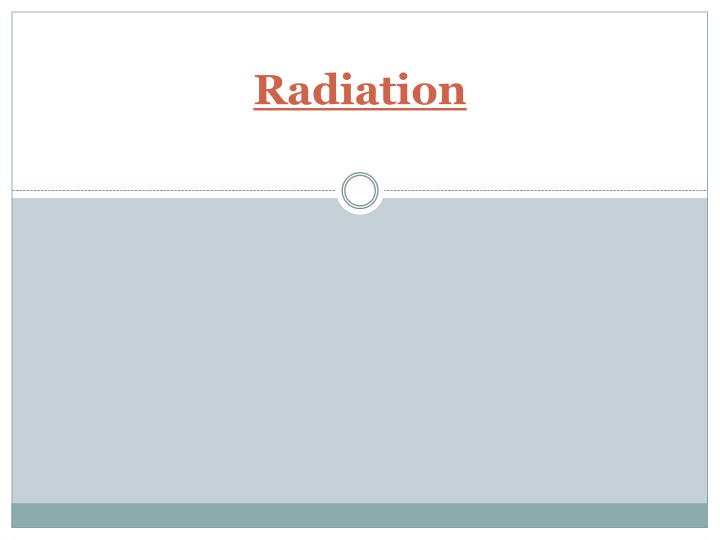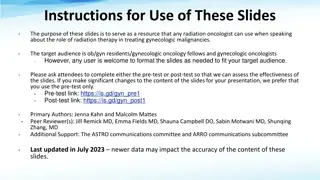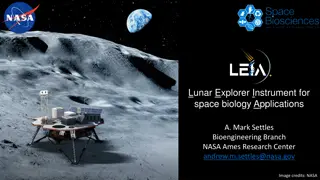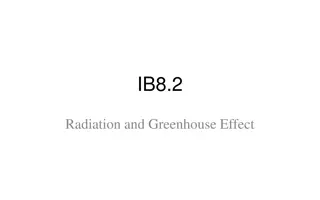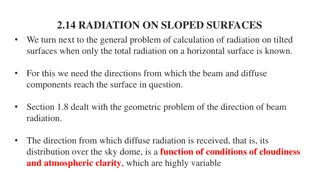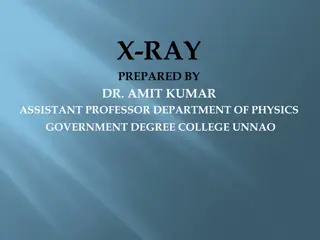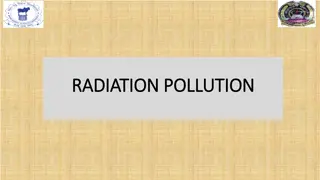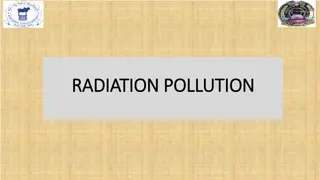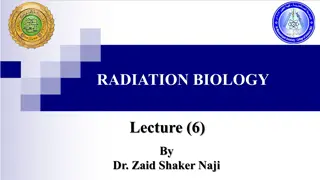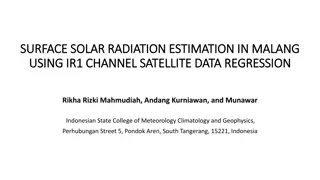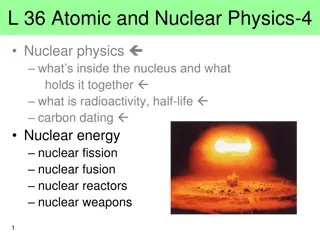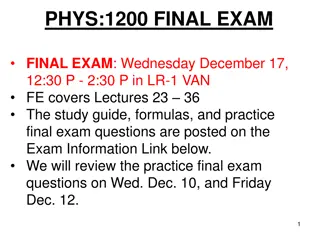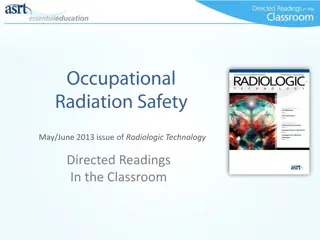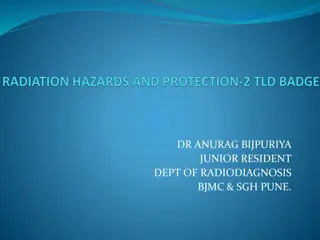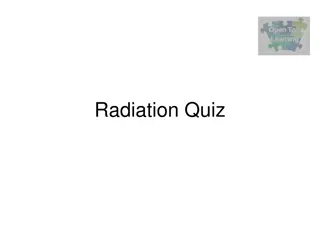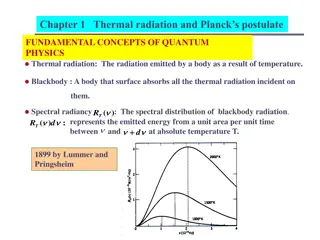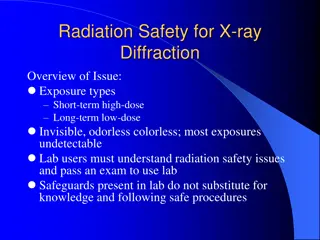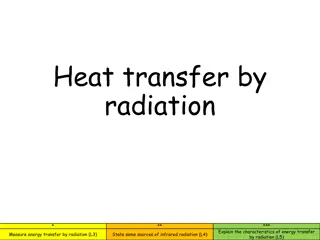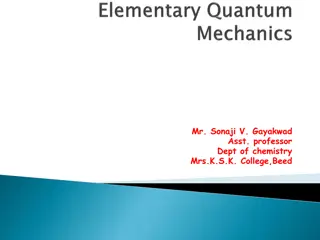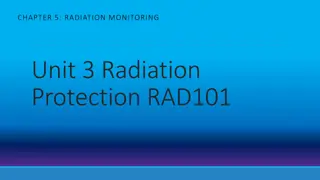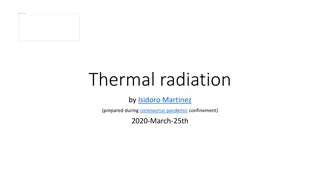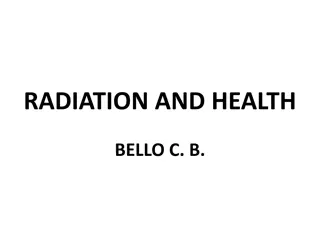Radiation
Radiation is the energy particles or waves emitted from radioactive elements, involving the atom's nucleus. Learn about nuclear radiation, isotopes, radioisotopes, ionizing and non-ionizing radiation, and types of ionized radiation like Alpha Radiation. Explore the concepts of mass number, atomic weight, and the decay process of radioisotopes. Discover how radiation interacts with matter and its various forms in the electromagnetic spectrum.
Download Presentation

Please find below an Image/Link to download the presentation.
The content on the website is provided AS IS for your information and personal use only. It may not be sold, licensed, or shared on other websites without obtaining consent from the author.If you encounter any issues during the download, it is possible that the publisher has removed the file from their server.
You are allowed to download the files provided on this website for personal or commercial use, subject to the condition that they are used lawfully. All files are the property of their respective owners.
The content on the website is provided AS IS for your information and personal use only. It may not be sold, licensed, or shared on other websites without obtaining consent from the author.
E N D
Presentation Transcript
mass number---4He2 ----Atomic number Atomic number. The number of proton in the nucleus Mass number. The sum of neutrons and protons in the nucleus .
Nuclear radiation Is defined as the energy particles or rays that are given off from a radioactive element, during reactions that involve the nucleus of an atom. Examples:During the fission of U-235 the nuclear radiation that is released contains neutrons and gamma ray photons. Isotopes: Atoms of the same element that have different masses because they have different number of neutrons
Approximate Atomic Weight (gm/mol) Atomic Number Element Name Neutrons Protons Element Carbon-12, 12C Carbon-13, 13C Carbon-14, 14C Carbon 12 6 6 6 Carbon Carbon 13 6 7 6 Carbon Carbon 14 6 8 6 Carbon
Radioisotopes A radioisotope is an isotope of an element that undergoes spontaneous decay and emits radiation as it decays. During the decay process, it becomes less radioactive over time, eventually becoming stable.
Radiation: Is a process in which atom emit energetic particles or energetic waves travel through a medium or space. Two types of radiation are commonly differentiated in the way they interact with normal chemical matter: 1-Ionizing radiation 2-Non-ionizing radiation.
Ionizing radiation Is radiation with enough energy so that during an interaction with an atom, it can remove tightly bound electrons from their orbits, causing the atom to become charged or ionized. Examples are gamma rays and neutrons.
Non-ionizing radiation: Is radiation without enough energy to remove tightly bound electrons from their orbits around atoms. Examples are microwaves and visible light.
Types of ionized radiation. Alpha Radiation Its stream of particles contains two protons and two neutrons. Its identical to the nucleus of the He atom .4He2 238U92=>234Th90+ 4He2
Characteristics of alpha radiation 1-Two neutrons and two protons. 2- Charge of +2. 3- Emitted from nucleus of radioactive atoms 4-Transfer energy in very short distances (10 cm in air). 5- Shielded by paper or layer of skin. 6-Alpha emitters can accumulate in tissue (bone, kidney, liver, lung, spleen) causing local damage.
2-Beta Radiation It's also a stream of particles, but the particles are electron formed in the nucleus by the converted of neutron into a proton. The electron is emitted as a beta particle and the proton remains in the nucleus. 3H1=>3He2+ 0e-
Characteristics of beta radiation 1- Small electrically charged particles similar to electrons. 2- Charge of -1. 3-Ejected from nuclei of radioactive atoms. 4- Emitted with various kinetic energies. 5- Shielded by wood, body penetration 0.2 to 1.3 cm depending on energy. 6- Can cause skin burns or be an internal hazard of ingested.
3-Photon radiation (gamma [] and X-ray) Photon radiation is electromagnetic radiation. There are two types of photon radiation 1- Gamma radiation :consists of photons that originate from within the nucleus. 2- X-ray radiation :consists of photons that originate from outside the nucleus, and are typically lower in energy than gamma radiation.
Gamma radiation 1-Electromagnetic photons or radiation (identical to x-rays except for source). 2- Emitted from nucleus of radioactive atoms spontaneous emission. 3- Emitted with kinetic energy related to radioactive source. 4- Highly penetrating extensive shielding required. 5- Serious external radiation hazard.
X-RAYS 1-Overlap with gamma-rays. 2- Electromagnetic photons or radiation. 3- Produced when electrons strike a target material inside and x-ray tube. 4-Emitted with various energies & wavelengths. 5-Highly penetrating extensive shielding required. 6- External radiation hazard.
4-Neutron radiation (1n) Apart from cosmic radiation, spontaneous fission. A common source of neutrons is the nuclear reactor, in which the splitting of a uranium or plutonium nucleus is accompanied by the emission of neutrons. The neutrons emitted from one fission event can strike the nucleus of an adjacent atom and cause another fission event, inducing a chain reaction .
Characteristics of neutron radiation 1-Neutrons are able to penetrate tissues and organs of the human body when the radiation source is outside the body. 2-Neutrons can also be hazardous if neutron- emitting nuclear substances are deposited inside the body. 3- Neutron radiation is best shielded or absorbed by materials that contain hydrogen atoms, such as paraffin wax and plastics. This is because neutrons and hydrogen atoms have similar atomic weights and readily undergo collisions between each other. :
Nuclear fusion: Fusion (meaning to join together)results from the combination of two small nuclei to form a larger nucleus with the concurrent release of large amounts of energy. An example of fusion reaction is the combination of two isotopes of hydrogen: deuterium and tritium, to produce helium ,a neutron, and energy. 12H+13H 24He +01n +energy small nuclei combine ) (
Nuclear fission Fission (splitting ) occurs when a heavy nuclear particle is split into smaller nuclei by a smaller nuclear particle (such as a neutron).this splitting process is accompanied by the release of large a mounts of energy. large nuclei break up :) ( 235U +1n 236U 141Ba+92Kr+31n+energy 92 0 92 56 36 0
5-positron emission Is a particle that has the same mass as an electron, but the opposite charge+1.its form by the converts a proton in to neutron. 7Be4=>7Li3+ 01
Helium nucleus Unstable nucleus Photon Spontaneous Decay Electron
Nuclear reaction: Can be used to represent the process of radioactive decay. In radioactive decay an isotopes breaks down, producing a new isotopes, smaller particles, and /or energy.
238U92=>234Th90+ 4He2 226Ra88=>222Rn86+4 +2 59Fe26=>59Co27+ 0 -1 18F9=>18O8+ 0 +1 Ex .Balance each of the following nuclear equation ? 40K19=>40Ca20+ X 224Ra88=>220Rn86+ X
Half life (t1/2) Is the time required for one-half of a given quantity of substance to undergo change . Each isotope has a characteristic half-life rang from milliseconds to several billion years. The importance of the half-life of radioactive isotope is that it tells us how long a sample of the isotope will exist.
Example A 50 mg supply of iodine-131,used in hospitals in the treatment of hyperthyroidism,was stored for 32.4 days.If the half-life of iodine-131is 8.1days,how many milligrams remain? Solution: N=time of stored 1/t1/2 =32.4days 1/8.1days =4 Then calculate the amount remaining 50mg-----25mg--------12.5mg-----6.25mg-------3.13mg Hence,3.13mg of iodine-131 remain after 32.4 days. (N=number of decay)
Biological Effects of Radiation The action of radiation on the cell is classified as either : 1-Direct effect 2- Indirect effect
Direct effect 1-Radiation directly attacks the DNA of the water molecule and ionizes water molecule electrons are release 2-The ionized water molecules can react further - forming highly reactive molecules such as hydrogen peroxide(H2O2), or radicals such as hydroperoxyl(O2H). 3-Biologic chain reaction occurring.
Indirect Attack When free radicals produced by the interaction of radiation with water molecules act on a vital molecule such as DNA, the damaging action of the ionization radiation is indirect.
Indirect effect Direct effect
There are 3 main uses of ionising radiation in medicine: Treatment Diagnosis Sterilisation
The aims of radiation therapy The aim of radiation therapy is to cause damage to the cancerous cells whilst minimizing the risk to surrounding healthy tissue. The damage inflicted by radiation therapy causes the cancerous cells to stop reproducing and thus the tumor shrink
Diagnosis In nuclear medicine, a tracer is a radioactive substance which is taken into the body either, as an injection, or as a drink. Such a substance is normally a gamma emitter which is detected and monitored. This gives an indication of any problems that may be present in body organs or tissues by how much, or how little, of the substance has been absorbed.
Factors which affect the choice of tracer 1-They will concentrate in the organ, or tissue, which is to be examined. 2-They will lose their radioactivity (short t). 3-They emit gamma rays which will be detected outside the body.
Medical application of radiation 1- Determine whether or not organs are functioning normally, 2-Show whether the blood supply to the heart is adequate, 3-Detect cancers at an early stage, 4-Locate a bone fracture before it can be seen on an X-ray. 5-Determine the extent of cancer and assess the response of cancer to treatment,
Isotope Medical application Fe-59 Measurement the rate of formation and lifetime of red blood cells Tc-99 Used to image the brain,heart,liver,lungs,spleen and other organ Na-24 Used to study the circulatory system Ce-141 Gastrointestinal tract diagnosis; measuring myocardial flow. I-123 Imaging brain,thyroid,kidney and heart Sr-85 Detection of bone lesion; brain scans. Sr-89 treatment of prostate cancer.
Radiation exposure and safety 1-Magnitude of the half-life Radio isotopes selected should have a short half-life time and should be in the form of a compound that will be eliminated from the body shortly after its diagnosis. 2-Types of radiation emitted Radio isotope emitting -particles is not generally used, because it has too low penetrating power to be detected outside the body. or emitting radioisotopes must be located to the skin to concentrate in the area wanted to be detected.
3-shielding: Shielding material (lead) is used to protect the body against radiation. 4-Time of exposure: The length of time of exposure will be shorted to the less amount that the dosage of radiation will be absorbed. 5-Distance from the radioactive source: Exposure to external radiation may be controlled by increasing distance between body and source of radiation
Sterilisation Radiation not only kills cells, it can also kill germs or bacteria medical instruments (e.g. syringes) are pre packed and then irradiation using an intense gamma ray source. This kills any germs or bacteria but does not damage the syringe, nor make it radioactive
